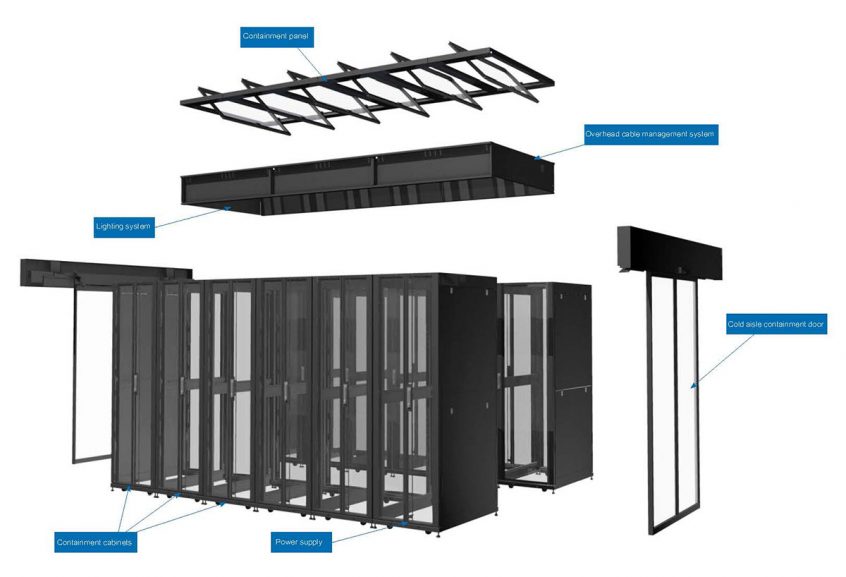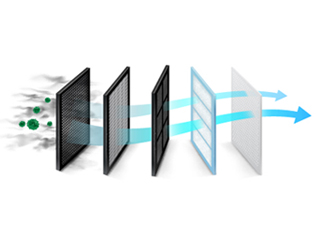Row-Level Airflow Management
Row-level airflow management is the process of improving cold aisle and hot aisle containment through the management of airflow within the containment aisle. After enhancing airflow management (AFM) at the Rack and raising floor levels, the next step in lowering energy usage should be to evaluate air dispersion in rows.
Row-Level Airflow Management Best Practices
Simply defined, row-level airflow management refers to enhancing the separation of the cold and hot aisles. It’s usually completed after you’ve improved the rack level airflow. When we discuss enhancing row-level airflow efficiency with data center operators, they tend to leap forward to confinement a little too quickly. The truth is that various locations in the row can be addressed without launching a full-fledged containment effort.
But, before we get into cost-effective row-level practices, it’s important to remember that the purpose of any airflow management program should be to increase the intake air temperatures in IT equipment. Operating your data center with higher air intake temperatures requires less cooling energy to be spent. Of course, there is a trade-off, not to run too hot and endanger the IT equipment. ASHRAE recommends somewhere around 22-25°C. Many data centers run colder than this. While running colder gives certain advantages, such as more margin for error, it increases operational costs and carbon footprint. Add into that mixing air, improper containment, you can be wasting large amounts of cooling energy. Many of the advantages of airflow management, such as better efficiency, expanded capacity, and lower operating costs, can only be realized if these improvements are made.
Block Open Spaces Underneath Cabinets
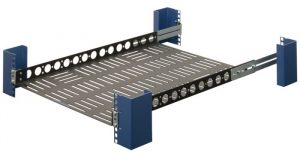
Photo Credit: www.racksolutions.eu
Although you might not realize it, the little distance between the bottom of an IT rack and the raised floor or slab can have a major impact on airflow management and IT equipment intake temperatures. This area, which is usually 1-2 inches high and the width of the rack, permits IT equipment exhaust air to pass under the rack and eventually back into the IT equipment air inlets. it can also allow cold air to leak under the rack where it is wasted rather than being forced through the IT equipment. Exhaust air recirculation can generate a number of issues in the data center, including higher intake temperatures, hot spots, and a higher risk of IT equipment failure in the long run. To combat the mixing, more cooling units will be required, as well as higher fan speeds and lower cooling unit temperature set points. However, using under-rack panels to close up these open gaps is a simple and cost-effective solution to lower your IT equipment’s intake temperatures.
Seal Spaces In Your Cabinet Rows
When we visit a data center, we frequently discover gaps between cabinets that haven’t been sealed, resulting in efficiency losses. Sealing these cracks is crucial for a number of reasons. Exhaust air recirculation is possible, just as it is with gaps beneath racks. Second, a significant amount of conditioned supply air can escape. When any amount of supply air bypasses IT equipment and returns to the cooling unit unutilized, this is known as bypass airflow. Bypass airflow, like exhaust air entering the cold aisle, necessitates the use of larger cooling units or greater fan speeds to compensate for the loss of conditioned airflow volume. Blocking off any open area between cabinets using rack gap panels or sealing foam, whether it’s a few inches or a few feet, will have a significant impact on IT equipment intake temperatures at a low cost.
There are still creative ways to limit bypass airflow even if a cabinet is missing at the end of an aisle, generating uneven aisle lengths. By allowing the attachment of rack gap panels and aisle-end doors, an adjustable mounting post, for example, provides a structural support surface to shore up uneven rows.
Contain Hot Or Cold Aisle Ends With Doors

Photo Credit: cool-shield.com
To gain the benefits of aisle-end doors, you don’t need to embark on a full-fledged containment project. Because of the considerable potential for hot exhaust air to loop around the ends of rows, cabinets near the extremities of rows are the most vulnerable to elevated IT equipment intake temperatures. Aisle-end doors, whether used in hot or cold aisles, will provide significant benefits by minimizing exhaust air recirculation in this region.
There are a variety of door options available at various price points, but the major cost savings benefit comes from the opportunity to forgo the cost of full confinement. Whether you’re implementing containment in stages or making a budgetary decision, aisle-end doors are a cost-effective solution that may be implemented all at once while still minimizing IT equipment intake temperatures.
Contain The Tops Of Cabinets
The next step in containment is to contain cabinet tops on either the hot or cold aisles, which is often used in instances with high cabinet densities or when maximum efficiency is sought. To contain conditioned supply air in chilly aisles, walls, baffles, or roofs over the aisle are used. A configuration of baffles or ductwork runs from the hot aisle to the cooling unit returns in hot aisles.
There is a vast range of options and costs, just as there is with doors. Options, unlike doors, come in a wide range of styles. In most cases, full containment is unnecessary. Angled cold aisle baffles and vertical hot aisle baffles, in our experience, get the job done and are cost-effective.
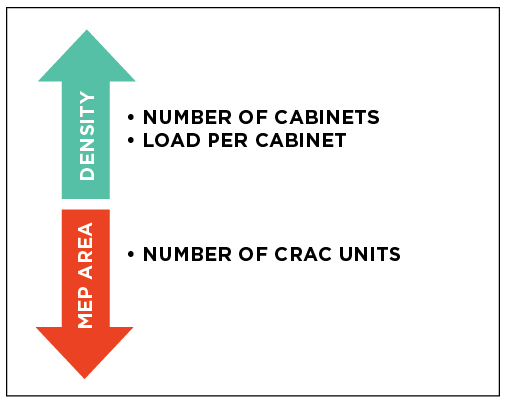
Photo Credit: journal.uptimeinstitute.com
Modular Solutions
It has traditionally been required to employ a third-party crew to implement many airflow management measures, particularly aisle confinement. This is no longer necessary, thankfully. Magnetic attachments can be utilized for under-rack panels, rack gap panels for gaps between rows, aisle-end doors, and rack-top baffles, which all address the best practices we’ve addressed. By removing the need for outside installation assistance, you can get a faster return on investment (ROI) from your airflow management upgrades.
Match Cooling Capacity With IT Load
The next stage is to match the cooling requirements of the IT load to the cooling capacity of the cooling units. Raising set points, lowering fan speeds, or turning cooling units off completely can all be used to match. This is an iterative procedure that should be carried out in small steps, with the intake temperatures of IT equipment being monitored at all times. In our upcoming piece, we’ll go over this method.
Row-Level Airflow Management Is Not All About Containment
If you want to manage airflow correctly, you’ll need to seal a lot of holes and gaps in the row. Hot or cold aisle containment is required in cases where cabinet densities are sufficient or maximum efficiency is sought. That isn’t to say that full containment is the sole option. To minimize IT equipment intake temperatures, partial confinement in the form of merely aisle-end doors is an exceptionally effective method.
Modular baffles are also cost-efficient and just as effective as a full roof or ducting in cold and hot aisles, respectively, when top-of-rack containment is required. Finally, keep an eye out for new magnetic airflow management technologies for row-level airflow management. They’ll save you the most money by lowering or eliminating installation charges entirely.
AKCP Airflow Monitoring in Data Center
Static electricity and dust build-up on computer fans, which can cause device failure, are controlled by airflow. One of the most crucial aspects of cooling your data system is airflow. Air conditioning alone will not be sufficient to safeguard your data center. Airflow sensors can monitor the amount of air arriving via a floor-located conduit for cooling purposes, such as ensuring that networking cables do not obstruct the conduit and cut off the chilling supply. Airflow sensors can also be used to guarantee that hot air returns are not obstructed in the same way.
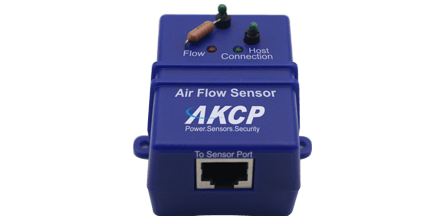
AKCP AIRFLOW SENSORS
The AKCP airflow sensor ensures that the system will operate at maximum efficiency and that you will be notified promptly if airflow drops. Larger rooms sometimes necessitate more sensor data in order to identify potential cooling efficiency issues. It’s critical to track the pace of airflow in order to assess the environment’s general health.
The AKCP airflow sensor is intended for use in systems that create heat during operation and require a constant flow of air to dissipate this heat. If the cooling airflow ceases, the system’s dependability and safety may be threatened.
The Airflow sensor is installed in the airstream’s path, allowing the user to monitor the flow of air. The airflow sensor isn’t a high-precision instrument. The purpose of this device is to determine whether airflow is there or not.
Reference Links:
https://www.upsite.com/blog/containment-strategies-identifying-the-best-conditions-for-cold-air-containment/
https://ext-5746154.livejournal.com/3895.html
https://altimirsolutions.com/cold-aisle-containment/
https://eagle-aluminum.com/aluminum-cold-aisle-containment-solutions/
https://ieeexplore.ieee.org/document/6892362
https://www.tateinc.com/en-au/learning-center/aisle-containment-for-data-centres/cold-aisle-containment
https://www.missioncriticalmagazine.com/articles/92823-managing-airflow-at-the-row-level

